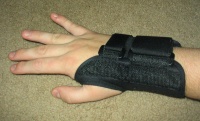Carpal Tunnel Syndrome
Original Editor - Kristin Sartore
Lead Editors - Your name will be added here if you are a lead editor on this page. Read more.
Clinically Relevant Anatomy
[edit | edit source]
The anatomy of the carpal tunnel is such that you have 8 small wrist bones called carpals that make up 3 sides of the tunnel and a thick transverse ligament that makes up the fourth side. The carpal tunnel is a narrow passageway between the capal bones and the transverse ligament and is located on the palm side of your wrist. The flexor tendons of the wrist as well as the median nerve travel through this tunnel.
Mechanism of Injury / Pathological Process
[edit | edit source]
Carpal Tunnel Syndrome (CTS) is a cause of functional impairment and chronic wrist pain of the hand. It results from compression of the median nerve as it passes through the carpal tunnel. An increase in synovial fluid pressure and tendon tension/inflmmation can cause compression of the median nerve in the carpal tunnel. Excessive repetitive movements of the arms, wrists or hands from activities such as painting or typing can aggravate the carpal tunnel bringing out the symptoms of carpal tunnel syndrome.
The compression of the median nerve may results from numerous factors, several of which can easily be remembered by using the mnemonic PRAGMATIC: Pregnancy secondary to fluid retension, Renal dysfunction, Acromegaly, Gout and pseudogout, Myxedema or mass, Amyotrophy, Trauma, Infection, and Collagen disorders.[1]
Clinical Presentation[edit | edit source]
The clinical features of this syndrome include intermittent pain and paresthesias in median nerve distribution of the hand, muscle weakness, and night pain. Usually, people with CTS first notice a numbness or "falling asleep" sensation in their thumb, index and middle finger at night. As the symptoms progress, people with CTS may complain of burning pain and numbness along the median nerve distribution (radial three and a half digits on the palmar side; index, middle and ring finger on dorsal surface of the hand) up into the center of their forearm.
Median nerve conduction study and EMG study are two diagnostic test that can be performed to diagnosis CTS.
Tinel’s sign and Phalen’s test are two special test that can be performed in the clinic to help diagnose. Wainner et al developed a clinical prediction rule to help test for the presence of CTS. The rule consist of 5 predictor variables: Age greater than 45, patient reports shaking hands relieves symptoms, wrist ratio index >.67, reduced median sensory field of the first digit, and Symptom Severity Scale score >1.9.[2]
Outcome Measures
[edit | edit source]
Outcome Measures Symptom Severity Scale is a self-administered questionnarie for the assessment of severity of symptoms and functional status in paitents who have carpal tunnel syndrome. A study by Levine et al demonstrated that the instrument is reproducible, internally consistent, valid, and responsive to clinical change.[3]
DASH - The disabilities of the arm, shoulder and hand (DASH) questionnaire is a self-administered region-specific outcome instrument developed as a measure of self-rated upper-extremity disability and symptoms. The DASH consists mainly of a 30-item disability/symptom scale, scored 0 (no disability) to 100. The DASH can detect and differentiate small and large changes in disability over time after surgery in patients with upper extremity musculoskeletal disorders.[4]
Management / InterventionsConservative[edit | edit source]
Non-Surgical managment
[edit | edit source]
Non-surgical managment includes use of splints, activity modification, patient education, diuretics, and NSAIDs. A number of nonsurgical interventions benefit CTS in the short term, but there is sparse evidence on the midterm and long-term effectiveness of these interventions[5].
Surgical Management
[edit | edit source]
Surgical treatment seems to be more effective than splinting or anti-inflammatory drugs plus hand therapy in the midterm and long term to treat CTS[5]. However, there is no unequivocal evidence that suggests one surgical treatment is more effective than the other[5].
Differential Diagnosis
[edit | edit source]
Differential diagnosis for CTS includes cervical radiculopathy, thoracic outlet syndrome, pronator syndrome, wrist joint arthritis, tendonitis, and fibrositis.[1]
Key Evidence[edit | edit source]
Bionka M. Huisstede, Peter Hoogvliet, Manon S. Randsdorp, Suzanne Glerum, Marienke van Middelkoop and Bart W. Koes. Carpal tunnel syndrome. Part I: effectiveness of nonsurgical treatments – a systematic review. Arch Phys Med Rehabil. 2010 Jul;91(7):981-1004.
Bionka M. Huisstede, Manon S. Randsdorp, J. Henk Coert, Suzanne Glerum, Marienke van Middelkoop and Bart W. Koes. Carpal tunnel syndrome. Part II: effectiveness of surgical treatments–a systematic review. Arch Phys Med Rehabil. 2010 Jul;91(7):1005-24.
Resources [edit | edit source]
Dutton, M. Orthopaedic examination, evaluation, and intervention. New York: McGraw Hill; 2004.
Flynn TW, Cleland JA, Whitman JM. Users' guide to the musculoskeletal examination. Fundamentals for the evidence-based clinician. United States:Evidence in Motion; 2008.
Case Studies[edit | edit source]
add links to case studies here (case studies should be added on new pages using the case study template)
Recent Related Research (from Pubmed)[edit | edit source]
Failed to load RSS feed from http://eutils.ncbi.nlm.nih.gov/entrez/eutils/erss.cgi?rss_guid=1NAkULqPpWyXeuwgkoIgQjum7qt0EVgMoGSsT3Nu36deF_ok4n|charset=UTF-8|short|max=10: Error parsing XML for RSS
References[edit | edit source]
References will automatically be added here, see adding references tutorial.
- ↑ 1.0 1.1 Dutton, M. Orthopaedic examination, evaluation, and intervention. New York: McGraw Hill; 2004
- ↑ Flynn TW, Cleland JA, Whitman JM. Users' guide to the musculoskeletal examination. Fundamentals for the evidence-based clinician. United States:Evidence in Motion; 2008.
- ↑ Journal of Bone and Joint Surgery
- ↑ BMC Musculoskeletal Disorders
- ↑ 5.0 5.1 5.2 Bionka M. Huisstede, Peter Hoogvliet, Manon S. Randsdorp, Suzanne Glerum, Marienke van Middelkoop and Bart W. Koes. Carpal tunnel syndrome. Part I: effectiveness of nonsurgical treatments – a systematic review. Arch Phys Med Rehabil. 2010 Jul;91(7):981-1004.








